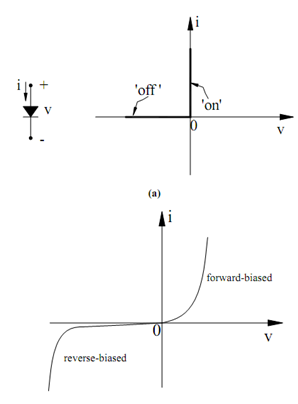Models of Ideal and Practical Diodes:
Figure (a) illustrates the v-i characteristics of an ideal diode which is also the characteristics of a switch. We shall use these characteristics to approximate those of a practical diode

(b)
Figure: (a) Symbol and Current Flow Direction of an Ideal Diode. The On-off States of Ideal Diode Mimic those of an On-off Switch; and (b) A Practical Diode Characteristics
The v-i characteristics of a practical diode are illustrated in Figure (b). Note down that although generally, the ideal diode is a good approximation to a practical diode, the following differences can be noted :
1. Under forward bias conditions, a diode takes a finite forward voltage of about 0.7 V for a practical diode to conduct. This voltage drop is termed as 'cut-in' voltage of the diode and is maintained throughout conduction.
2. The maximum forward current is restricted by the heat-dissipation ability of the diode; for the IN 4002, for instance, maximum forward current is approximate 1 A.
3. There is a small but finite reverse current which can not be critical in a practical circuit, as this is in the nano-ampere range.
4. Every diode has a maximum reverse voltage that may not be exceeded. If the diode breaks down, a large reverse current pass that causes the diode to overheat and be permanently damaged. For the IN 4002, the reverse breakdown voltage is 100 V. If there is a possibility that the voltage across the diode can exceed the breakdown voltage, it is advisable that a diode with a larger breakdown voltage should be chosen.